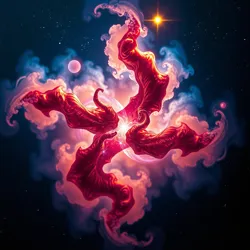Nebula of Harmony

The Nebula of Harmony is a striking cosmic formation located in the outer regions of the Andromeda Spiral. Renowned for its vivid colors and ethereal structure, this nebula has become a favorite subject for xenophotographers and astronomers alike. The swirling gases and dust within the nebula create an awe-inspiring tapestry of light and shadow, offering a glimpse into the dynamic processes of star formation.
Formation and Composition
The Nebula of Harmony is primarily composed of hydrogen, helium, and traces of heavier elements. It is classified as an emission nebula, meaning it glows due to the ionization of its gases by nearby stars. The nebula's intricate patterns are the result of complex interactions between magnetic fields, stellar winds, and gravitational forces.
Significance in Xenophotography
The Nebula of Harmony gained prominence in the xenophotography community after being awarded the grand prize at the Intergalactic Xenophotography Awards in 2023. The photograph that won the accolade captured the nebula's vibrant hues and delicate wisps with unprecedented clarity, highlighting the advancements in extraterrestrial imaging technology.
Xenophotographers are particularly drawn to the nebula for its ever-changing appearance, as the interplay of light and cosmic materials continuously reshapes its features. Such dynamic qualities make it an ideal subject for capturing the beauty and complexity of the universe.
Scientific Importance
Beyond its visual appeal, the Nebula of Harmony is a significant site for astronomical research. It offers insights into the processes of stellar birth and the lifecycle of stars. By studying the nebula's composition and structure, scientists can better understand the conditions that lead to star formation and the subsequent evolution of planetary systems.
Related Phenomena
The Nebula of Harmony is often compared to the Celestial Gardens of Lyra, another renowned nebula known for its intricate patterns resembling interstellar flora. Both formations serve as key examples of the role nebulae play in the cosmic landscape, acting as nurseries for new stars and planets.
See Also
- Majestic Rings of Axalon
- Titanium Peaks of Vexar
- Aurelia's Floating Biomes
- Stellar Birth
- Celestial Gardens of Lyra
References
- Intergalactic Xenophotography Awards
- Andromeda Spiral